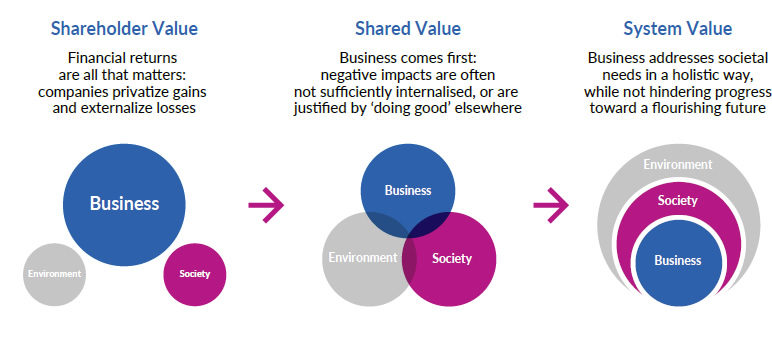Please welcome Ania Pitula, a devoted staff member of Sustainability Leadership, who is our guest blogger for this month’s post on “Building A Triple-Bottom-Line Business”.
The triple-bottom line is a framework which was created to help businesses design a balanced division of social, economic and environmental value into their services. While traditional business models have primarily focused on financial returns first or have placed equal value on economic, environmental and social components, the “trip-bottom-line” framework intends to use a more systemic approach. In this way, a healthy environment fosters the wellbeing of social systems which ultimately harnesses business success.
The starting point of becoming or maintaining your identity as a sustainable business begins with looking at the internal structure of your business model. It’s important to recognize where your business stands with its current systems and identify how you can create a policy that helps your organisation run its operations according to the best sustainability standards.
Our Sustainability Leadership Program is intended to guide you through the process of creating a sustainability report. We offer the tools which help guide you through the process of becoming transparent about your sustainability initiatives, decide where to focus your efforts, indicate that you are taking action and reflecting responsibility. We also help you understand how to create a sustainability policy for your organisation to follow or how to formally report and become recognised for your initiatives.
Creating a sustainability report is an excellent way to create a value-add to your business for all stakeholders, including consumers and investors. By simply having a sustainability policy and goals in place, you are joining the growing network of triple-bottom-line-based businesses moving towards the most radical upgrade in the definition of true sustainability.
Some well-known companies that are taking the lead in this area include: Ben & Jerry’s, Lego, Starbucks, Bell Canada and The Home Depot.
Sustainability as a general goal can feel difficult. It’s incredibly important to breakdown the topic into three main areas of focus that align with the “triple-bottom-line” framework, including people, planet and profit. It’s also important to accept that sustainability is a gradual development process which may often need to be reassessed.
The aim of true sustainability is about progress, not perfection. We want to help you focus and narrow down on the specific direction of your plans and create optimal opportunities for action which align with your goals. Below you’ll find the areas to concentrate your efforts in to create the most balanced approach to sustainability and develop a more holistic business model.
Environmental Initiatives.
We’ll tackle the broadest realm of the triple-bottom-framework first. Let’s consider the impacts your business has on environment or ecological health. Criteria to focus on here includes a company’s:
- Energy use
- Waste management
- Pollution/Greenhouse Gas Emission contributions
- Responsible material sourcing (natural resource depletion – conservation ratio)
- Ethical treatment of animals
Social Initiatives.
Social criteria is based on the needs and wellbeing of all the people directly involved in your organisation, (such as all levels of staff, volunteers, interns and students) and both the local community around you and broader public sphere. Your efforts should include:
- Respectful collective work culture and individual mental health consideration
- Worker physical Health & Safety, Human Rights, Inclusion, diversity & Equality
- Healthy supply chain relationships
- Positive community impact & involvement
- True alignment with the mission and values of your organisation
Economic Initiatives.
Economic initiatives specifically relate to the financial success, functional stability and legal status of your business. They also refer to procurement practices (local and policy), local hiring, and job skills training. It’s important to be accurate, ethical and transparent with:
- Accounting methods
- Avoiding any conflict of interest
- Fair investor relations
- Legal practices
All of these factors are reflected in the United Nation Sustainable Development Goals (SDG’s). The definition of business success is changing as the world transitions from traditional linear thinking (profit-first) models to a more strategic and wholesome way of generating long-term stability.



